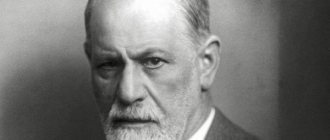Birth of the concept
Intention absorbed the main theses from scholasticism, which separated the mental (intentional) existence of an object and the real one. In the Middle Ages it was believed that there could be no knowledge of a subject without intervention in it. Thomas Aquinas discussed the nature of intention. He spoke about the formation of intention by the mind regarding an understood object. In the 19th century, with the light hand of psychologist F. Brentano, the concept took on a new life. He believed that consciousness is intentional, that is, directed towards what is outside itself. In other words, the concept brings meaning to consciousness. Scientists A. Meinong and E. Husserl developed in their scientific works various approaches to defining intention, which later had a significant impact on a number of areas in psychology (Gestalt psychology, personalism, and so on). Another philosopher, M. Heidegger, combined care and intentionality, believing that there is an internal connection between them. He argued that “man in his being is a being who cares about being.” If a person fails in his “being”, then he loses his possibilities.
Definition
Intention is a broad concept that can be described as the direction of thinking. The ability to think is born in every person in childhood. And it is at a young age that a child develops his own personal range of interests and a path to knowledge of the areas of interest to him. Under the influence of various internal and external factors, the baby forms his own picture of the world. He understands what is good and what is bad. Parents teach the child etiquette, competent speech and the basics of cultural behavior. By synthesizing this information, a person creates a base that he will use throughout his life. This basis is different for all people. You've probably encountered the problem that someone you know doesn't understand you, although it seems to you that you simply won't be able to explain it any more clearly. It may seem to you that the person opposite you is unimaginably stupid. But that's not true. Most likely, the direction of thinking between you and this person is very different. You look at the world differently and put different meanings into the same definition.
Intention – what is it?
There are several meanings of the term “intention”. The first explains it as “the focus of consciousness on an object.” Intentional processes include cognitive, emotional, motivational and other mental processes, since attitudes and feelings towards a subject can be different. The object of intention can really exist, or it can be invented, meaningful or absurd. The second interpretation of the concept of “intention” is presented as “goal orientation” or the target intention of an action.
Intentional processes
All people think differently. One person likes to delve into the essence of the problem, another prefers to look at the problem in general, without going into details. What processes take place in a person’s brain when he directs his thinking to some object or goal.
- Emotionality. Emotions help a person understand whether he likes an object or object of contemplation or reflection. If you like it, then you can continue studying or communicating. If something is unpleasant to a person, he will try to get rid of the negative thought or the horrifying object of contemplation as soon as possible.
- Motivation. Intention is the direction of thinking. It would not exist if a person did not have motivation. The desire to see something, go somewhere and do something is the main thing in a person’s healthy life.
- Cognition. A person strives for knowledge, and it helps him to better understand this world and the people living in it. Books also form a worldview and a picture of the world. They help a person gain passive experience, without spending any resources other than temporary ones.
Intention in psychology
In this science, the term refers to the internal orientation of consciousness towards a real or fictitious object, as well as the structure that gives meaning to experiences. Intention is the ability of a person to have intentions, the ability to participate in the events of the day, changing himself. One of the aspects of the concept is the ability to perceive an object from different sides, depending on the underlying meaning. For example, when considering real estate as a summer vacation spot for a family, a person will carefully familiarize himself with such issues as comfort, equipment, and leisure activities on the territory. If the same person buys the same property, then he will first of all pay attention to the ratio of price to quality of housing. Intention is the birth of a close connection with the outside world. In situations that are difficult to perceive, a person has learned to weaken the relationship until he is ready to understand the situation.
Text of the book “Intent Analysis. Reasons, procedure, experience of use"
Speech intentions of the subject
The practice of using intention analysis in psychological research is largely determined by ideas about the role of intentions in the formation of speech and verbal communication.
In order to reveal the capabilities of this method, it is necessary to dwell on the basic theoretical principles that form its basis. From the standpoint of intention analysis, the concept of “intention” is fundamental for the study of speech-language phenomena.
The natural question is what “intention” is, what is the role of intentions in speech and verbal communication.
“Intention” is a category with a long history, denoting in philosophy and psychology the activity of consciousness, the focus of consciousness on an object (F. Brentano, E. Husserl). There has also been a tradition of using this term in a narrower meaning - goal orientation (A. N. Leontyev), intention (New in Foreign..., 1986). Intentionality, or, according to Rubinstein, objective orientation, is an integral property of consciousness. Due to this fundamental property, consciousness is not a passive reflection, but a biased reflection that is capable of motivating activity (Rubinstein, 2003).
Intentionality plays an extremely important role in the development of speech and its mechanisms
. In the speech process, the initial impulse is the initiating impulse, the intention to express something, which manifests itself already at an early age and has an organic nature (Ushakova, 1998, 2004). Speech expresses the underlying semantic (T. N. Ushakova), or intentional state (J. Searle) - the state of consciousness of the speaker, the immanent feature of which is correlation with the world, focus on an object. In subjective terms, this internal psychological state represents “meanings.” In an adult, subjective meanings are organized in accordance with the rules of language and are manifested in the speech produced (Ushakova, 1998, 2004; Word in action..., 2000).
Acting as a necessary basis for speech, intentions also form a significant part of its psychological content. Intentional content of speech
directly related to the goals of the activity, desires, needs, preferences of the subject. Intentions are revealed, on the one hand, in what objects a person speaks about, what his consciousness is directed towards: himself, the communication partner, the surrounding reality. On the other hand, it is important how exactly these subjects are spoken about. A person uttering a statement performs a speech act: he asks, promises, advises, demands (New in foreign..., 1986). At the same time, along with typical intentions (offer, request, order), many other intentions are realized in speech - to express an attitude, avoid responsibility, carry out self-presentation, etc. (Word in action..., 2000; Pavlova, 1998, 2000; Discourse in the modern world, 2011). The intentional content of speech is multifaceted and, like any content, in principle inexhaustible.
Speech intentions
can be not only conscious, but also unconscious. They differ in their psychological depth. Clearly expressed “immediate” intentions make it possible for the interlocutor to understand the speaker and constitute the psychological reality of communication; such intentions are often consciously manifested by the subject. “Deep” intentions, including unconscious and deliberately veiled ones, can often be identified only as a result of special analysis. Speech intentions have a stable or, on the contrary, transient nature. Some of them, which are extremely important in organizing a conversation, arise directly during the interaction, in accordance with the steps taken by the communication partner. Other intentions are formed in connection with practical needs, professional activities, etc. (Pavlova, 2000; Discourse in the modern world, 2011; Kubrak, 2007; Grebenshchikova, Zachesova, 2014a; etc.).
The intentions of speech are diverse and can be typologized on many grounds. Inextricably linked both with the motivational and perceptual-cognitive processes of the subject, and with his involvement in practical life activities, they largely determine the speech content and its understanding by the interlocutor.
It is important to emphasize that the role of speech is not limited to the implementation of individual intentions of the subject (“ I demand...
" and so on.).
Intentions manifested in speech are usually coordinated with each other. A hierarchical intentional structure is formed,
often quite complex. In addition to the leading, or target, intentional directions of discourse, their constituent specific intentions are distinguished, which determine the functional specificity of the leading directions (Pavlova, 2000; Kubrak, 2009a; Grebenshchikova, Zachesova, 2014a; etc.).
In this case, the special role of the subject’s orientation towards the addressee, dialogical intentions,
which in an adult speaker are a constant component of the intentional content of speech (Pavlova, 2000). A person speaks, wanting to express something, and in order for what was said to be adequately perceived, he must take into account the addressee, including in mediated communication of an absent addressee, and in some situations, an imaginary one, i.e., form a certain recipient design (Mustajoki, 2015) , take the perspective of the interlocutor (Converse et al., 2008). If we exclude pathology and special moments of speech ontogenesis, the subject is directed towards the addressee, at least in the sense that he strives to be correctly understood. In addition, since speech is included in social practice, dialogic intentions regularly acquire a more specialized character: the speaker seeks to convince a partner, encourage him to act, express (cause) an attitude, warn, and many others. etc.
Ways of expression
The dialogical and other
intentions
of the subject are extremely diverse.
Along with open manifestation, when intention is directly indicated, for example, by the corresponding verb (“ I promise to help
”), various methods of indirect, implicit expression are widely used, in which it is not so much linguistic and non-verbal means that are important, but the conditions of communication, psychological prerequisites, etc. (New in foreign..., 1986). The intentional expressiveness of speech is enormous. However, the implicit transmission of intentions can lead to vague content that allows for different interpretations. This uncertainty is fundamental in communication. Allowing you to make clarifications and prepare actions, it is a prerequisite for tactful conversation.
Moreover, since the intentional states to be expressed are continuous, speech utterances turn out to be connected not with any one, but with many intentions that are in one connection or another. Some of these intentions are leading, others are of a subordinate nature, some intentions are clearly recognized by the subject, others may not be reflected. Statements in discourse, with few exceptions, are multi-intentional, and the question of what intentions it primarily serves to realize is often far from obvious (Discourse in the Modern World, 2011).
Despite the ambiguity of speech transmission, the subject’s intentions,
as a rule,
are understood by the addressee
. However, some blurring of their qualifications is revealed: confusion of similar categories, non-distinction of private intentions, etc. (Ushakova et al., 1998; Word in action..., 2000). Indirectly expressed intentions are understood less well than explicitly manifested ones. The breadth of expression also matters: the larger the volume of speech material the intention is manifested, the more reliably it is qualified (Pavlova, Peskova, 2012). In natural conditions of dialogue, the most significant factor in understanding intentional content is involvement in communication: the addressee relates statements to the situation, the communication partner, and asks clarifying questions.
Misunderstanding of speech intentions
may have the nature of an honest mistake and be determined by objective factors: situational interference, differences in the stock of knowledge available to communicants, insufficient identification of intentions (Discourse in modern..., 2011). At the same time, cases of so-called “communicative sabotage” are possible, which are associated with the positions of communication partners (Gorelov, Sedov, 2004). If a conscientious error entails corrective remarks and clarifying questions, indicating a desire to understand the interlocutor, then in a situation of “subjective misunderstanding” various tactics of avoiding an answer are common, such as prolonging the conversation, suggesting a new topic, reducing what was said as a joke, etc. This is found reflected in the mismatch of replicas, leads to disruptions in the flow of the conversation, and in some cases to communication failures. Usually, however, ignoring the partner’s intentions acts as a communicative tactic that allows one to influence the movement of the conversation (Grebenshchikova, Zachesova, 2014a; Afinogenova, 2015).
It is worth noting that if for the listener the form of expression of intentions is an objective factor that can complicate understanding, then from the perspective of the speaker it is a subjective factor that allows the discussion to develop for its own purposes. By varying the forms of expression, the communicator can veil some intentions and highlight and emphasize others. For a more vivid demonstration of intention, special expressive means are used: expressive vocabulary, repetitions, metaphors, etc. (Pavlova, Peskova, 2012; Pavlova, Zachesova, Grebenshchikova, 2016).
The processes of expression and recognition of intentions act as the most important component of verbal communication, a necessary basis for mutual understanding, coordination of actions, and achieving the goals of communicants
.
In conditions of direct interaction, speech transmission of intentions is included in the process of replica coordination
communication partners. The speaker manifests actual intentions in speech, and their understanding serves as the basis or partial basis for the interlocutor’s subsequent remarks. The mechanism of intentional coordination of replicas does not imply, of course, an unambiguous determination of subsequent replicas by previous ones. The partner's response can be either immediate or delayed. It can simultaneously refer to several expressed intentions, the reaction to which can be combined. Patterns of interaction that reflect a positive response to the intentions of the initiating remark are adjacent to patterns that reveal the response resistance or opposition of the partner (Afinogenova, Pavlova, 2015). Implemented intentions are prepared by the previous steps of the communication partners and are woven into the overall structure of the conversation, which acquires a consistent linear or complex and branched character (Grebenshchikova, Zachesova 2014a; Pavlova, Afinogenova, 2014).
At the same time, the intentions manifested in speech are largely determined by the situation in which communication takes place. Thus, in the conditions of the election campaign, politicians’ speeches are aimed at inspiring, consolidating, warning, stimulating voters to action, and discrediting a political opponent. These and other intentions inherent in the pre-election situation form an integral intentional space
of this type
of discourse
(Pavlova, Grigorieva, Peskova, 2007). Other types of discourse - family, scientific, consulting - have their own intentional characteristics and their own intentional space (Grebenshchikova, 2012; Kubrak, 2009a; Discourse in the modern world, 2011). The intentional space of discourse constitutes its psychological basis. It largely determines the nature of the discourse: the means and methods of expression used, methods of influence, and the range of topics discussed.
General methodological issues
3.1.
Units of discourse analysis When studying discourse, various units of analysis are used: interaction (E. Berne), speech act (J. Searle), communicative act (E.A. Zemskaya), communicative action (V.I. Karasik), communicative course (O S. Issers), etc. The general requirements for a unit of discourse analysis are formulated by G. G. Pocheptsov (2001):
a) the unit of analysis must be large enough to express the meaning;
b) it should be small enough not to express many meanings;
c) it must be easily identifiable;
d) the number of units must be so large that a sample can be made from them.
The choice of units of analysis should correspond to the properties of the discourse being studied. In this regard, one should distinguish between two groups of discourses, the organization of which specifies a different perspective on the consideration of intentional content and its own list of intentional categories. The first group is non-dialogue discourses,
having, as a rule, a fixed text form, prepared in advance, the addressee of which is not directly involved in the communication process (public speeches, publications in the press, scientific articles, etc.).
The second group is formed by dialogue types of discourse
, which usually arise in the process of direct communication, exist mostly in oral form and are characterized by a large degree of spontaneity (conversational practice in children, family, pedagogical, student communication, TV shows, etc.). The distinction between these groups is, of course, conditional: dialogicity is immanent in speech, as in consciousness as a whole (M. M. Bakhtin). It is permissible, however, to say that discourse can be studied as dialogical, and then the focus is on the process of interaction between two (or more) communicators, the change of roles between speaker and listener, etc., or as non-dialogue, when dialogicity appears in the form of orientation of speech to a certain audience.
Intent analysis of non-dialogue forms of discourse is based on the utterance (in a written text, a sentence) as the unit of analysis. Some intention analysis techniques (Word in Action..., 2000) involve the consideration of individual paragraphs.
Research techniques proposed in the context of the study of dialogue forms of speech are based on the selection of paired remarks. The first replica of the pair in a certain way influences the generation of the second, asking it in a narrow (greeting - return greeting, request for news - message) or wide range (accusation - response accusation / justification / question / ignoring). This can be a stimulus and a transactional reaction as part of a transaction (Bern, 1992), the first and second element in an adjacent pair (Goodwin, Heritage, 1990), illocutionarily related steps in a communicative exchange (Kibrik, Podleskaya, 2003), independent and dependent speech acts in minimal dialogue (Baranov, Kreidlin, 1992).
Intent analysis experience in this area relies on replica
– a complete semantic unity containing one or more intentions (Grebenshchikova, Zachesova, 2012, 2014a; Pavlova, Afinogenova, 2014). Unfinished utterances, of course, also contain a certain intentional content, which, however, is not always possible to qualify. The implementation of a plan can be carried out in several stages: for example, a sequence of several communicative moves of one interlocutor can serve as a single intention, expressed in a veiled manner and highlighted only when analyzing the entire dialogue as a whole.
The sequence of communicative moves of the subject, united by a common goal, forms the tactics of conversation, or convertive tactics.
Tactics are implemented and adjusted by the speaker in accordance with the response behavior of the communication partner.
The nature of interaction between subjects of communication can be assessed by the severity of certain intentional patterns
. The intentional pattern, which serves as the unit of analysis of the interaction process, has the following characteristics:
1. It contains communicative moves belonging to different interlocutors (at least two).
2. There is an intentional consistency between moves, which can be either supportive or rejecting: “ask - agree/deviate”, “carry out self-presentation - show approval/disapproval”.
3. The corresponding intentions can be located in adjacent moves or be separated by several moves of the interlocutors.
4. A polyintentional replica can form several intentional patterns.
5. The intentions that form an intentional pattern usually relate to one referential object[1]1
For more information about the options for intentional patterns, see Part 2, sections 4.2 and 4.4, which discuss various cases of responding to the manifestation of intention and the so-called illocutionary compulsion.
[Close].
It is important to note that when analyzing dialogue and non-dialogue forms of discourse, it is necessary to take into account both the context of the entire speech work and individual words, some of which can serve as markers of realized intentions.
It should be added that discourse can have one or another intentional saturation: behind a large volume of what is said, only one intention can be hidden, and, on the contrary, the implementation of many intentions can be presented in a brief presentation. 3.2.
The variety of intentions and the problem of their typology In connection with the variety of intentions that are expressed in speech, the question of their nomenclature and typology arises. The development of metalanguage in describing the totality of speech intentions is associated with the theory of speech acts.
In terms of this theory, the concept of speech intention is correlated with the concept of illocution (New in Foreign..., 1986). By uttering an utterance, a person performs a speech act that has a certain illocution that embodies the communicative intention of the speaker. In general terms, the number of speech acts is quite limited: “We tell others what the state of affairs is; we try to force others to do something; we commit ourselves to do something; we express our feelings and attitudes; finally, with the help of statements we introduce changes into the existing world” (Searle 1986, p. 194). This approach formed the basis of a typology, according to which there are five basic types of speech acts: representative, directive, commissive, expressive and declaration. Representatives,
which include such acts as assert, believe, conclude, their purpose is to fix the responsibility of the speaker for reporting a certain state of affairs, for the truth of the expressed judgment.
Directives:
order, command, ask, beg, etc., are aimed at getting the listener to perform a certain action.
Commissives
are various kinds of promises and oaths, the purpose of which is to impose on the speaker an obligation to perform an action or follow a certain line of behavior.
Expressives
- thank, congratulate, sympathize, regret - convey aspects of the speaker’s psychological state.
Declarations
by the very act of speaking constitute a fact:
“I resign,” “I appoint you to a position,” “I name you husband and wife.”
If according to J. Searle there are five types of speech acts, then other researchers describe up to several dozen types. Thus, in addition to those indicated, vocatives can be identified,
which includes appeals for the purpose of attracting attention and maintaining contact, and
retractives,
which denote speech acts of taking back a promise, adjusting a statement, etc. (Wunderlich, 1976).
In C. Bach's taxonomy, among others, constatives
(affirmation, announcement, response, agreement, assumption, denial, disagreement, exposure, challenging, informing, insisting, prediction, etc.) and
recognitions
- apology, condolences, congratulations, greetings, expression of gratitude, etc. (Bach, 2003).
O. G. Pocheptsov points to the existence of phatic
speech acts that implement the contact-establishing function, as well as
menatives
- speech acts of threat and
quesitives
- questions (Pocheptsov, 1975).
The authors of numerous typologies do not have a common point of view regarding the attribution of a particular speech act to a certain type. The original grounds for classification do not coincide either. At the same time, from a methodological point of view, the taxonomy of speech acts in itself is not as important as those differential features that distinguish them from each other and must be taken into account when assessing intentions. According to Searle, these are differences in the purpose of utterances, in the direction of “adjustment” between words and the world, correspondence to the interests of the speaker and the addressee, etc. In other typologies, along with these characteristics, factors of a different kind are taken into account: the speaker’s knowledge/ignorance of the experience and structure of reference of the addressee ; the degree of involvement of the speaker and the addressee in communication; the relationship of the speech act with the principles of communication and social goals, such as avoiding conflict (Bogdanov, 2007). These kinds of factors associated with the expression and transmission of intentions are important to keep in mind when conducting intent analysis.
The theory of speech acts and related studies adequately describe the main types of speech acts, establishing a connection between the expressed intention and the speaker’s idea of the situation, communication partner, etc. At the same time, research in this area is criticized for being overly theoretical, focusing on isolated statements and thought experiment data. If we move from individual statements to discourse, it is impossible to limit ourselves to a list of standard acts, the identification of which turns out to be largely formal and arbitrary. In natural discourse, other speech acts often turn out to be more relevant than those that are usually isolated and analyzed.
M. Stubbs, summarizing a series of works devoted to speech acts, names such important functions as expressive-emotive, directive-influencing, poetic, contact, metalinguistic, referential, contextual-situational (Stubbs, 1983). It is noted that since any utterance in discourse is multifunctional, a metalinguistic speech act, for example, can be at the same time directive (“ Go and look how correct this is in the dictionary!
"), expressive-emotive act - poetic ("
Leave me, old woman, I'm in sadness!
"), etc. The special role in the discourse of metacommunicative acts is emphasized, aimed at controlling the content of statements, distributing the roles of speaker - listener, checking the correctness understanding what was said.
Expansion of the list of speech intentions can be facilitated by the analysis of nominations of intentions in explanatory dictionaries, which record the experience of native speakers and the conceptualization of intentional content inherent in the language (Bogdanov, 2007). However, the problem of unifying names and reducing similar intentions into more general categories arises. Based on the material of the Russian language, using Searle’s typology and developed procedures (performativity criterion, question-answer test, etc.), more than a hundred representative and directives, several dozen commissives, over 280 expressives, etc. are identified (Savelyeva, 1991).
It is also important to note the presence of empirical lists of intentions compiled for certain areas of communication and types of discourse based on the communicative competence of researchers and/or respondents (see, for example: Arutyunov, Chebotarev, 1993), including the results of intention analysis (Afinogenova , 2015; Grebenshchikova, Zachesova, 2014a). Empirical research data reveals realities of discursive practice that do not fit well into the general classification (Pavlova, Grebenshchikova, 2014). Communication situations are diverse, and for each of them it is possible to describe the set of inherent intentions of the subjects of communication.
A separate problem is determining how to designate speech intentions. In the theory of speech acts and linguistic pragmatics, the use of nouns (“explanation”, “reproach”, “advice”, etc.) is used to nominate intentions. This tradition is followed when conducting intention analysis (Word in Action..., 2000). At the same time, since such nominations record the result of a speech act, which is justified when research is oriented primarily on speech means, rather than on performed speech acts and the corresponding psychological states, in recent years verbal nominations have also been used (“explain”, “ reproach", "report"). Verb nominations that emphasize the procedural aspect of speech are accepted in intention-analytic studies of dialogue forms of discourse. In addition, since in general, intentions include various emotions, relationships associated with referential objects, and mental states, a large number of nominations are used that contain the verb “express” (“express an opinion,” “express concern,” “express sympathy”) ").
Psychotherapeutic technique of V. Frankl
Intention in psychology is represented by a method, the essence of which is for a person to play out his fear or neurosis in a critical situation. The technique was developed by psychologist V. Frankl in 1927 and is still successfully used in practice. The method is called paradoxical intention. An example is the life of spouses who often sort things out. The psychotherapist invites them to quarrel as loudly and emotionally as possible, thereby making the unpleasant situation controllable. Another example: a schoolboy is afraid to give a report and trembles. As part of this method, he is asked to begin to tremble violently himself, thereby relieving the tension that has arisen. The method of paradoxical intention can lead to two results: an action or situation ceases to be painful and uncontrollable, or, by switching attention to the voluntary reproduction of experiences, it weakens their negative impact.
The essence of the psychotherapeutic method
Paradoxical intention, as a mechanism of action, considers the process of self-detachment, which allows the individual to get out of an unpleasant situation. The technique is based on the desire of the person himself to accomplish or for someone else to do (with a phobia) what he fears. The method of paradoxical intention is actively used in psychotherapy. It is especially effective when combined with humor. Fear is the body’s biological reaction to dangerous situations, and if the person himself looks for them and is able to act in spite of fear, then the negative feelings will soon disappear.
Desire to speak out
In linguistics, intention is the initial stage of the birth of an utterance, followed by motive, internal pronunciation and speech.
The concept under consideration is associated with specific communicative meanings that are expressed in the process of communication. Speech intention (in a broad sense) is the merging of need, goal and motive into one, which is formed into a message through the use of communicative means. In a narrower sense, the term is considered as an effective purpose and merges with the concept of an illocutionary act. Doctor of Philological Sciences N.I. Formanovskaya considers intention as a plan to structure speech in a certain key, form, style. The difficulty in studying this term lies in the uniqueness of the experimental object, with often vague communicative intentions. Speech messages are always connected with various extralinguistic events, so any, even simple, utterance is multidimensional. Performances have a strong-willed attitude and influence the addressee. There is a concept of speech intention of disapproval, which is an integral part of communication. This is a negative manifestation that can lead the conversation into conflict.
Linguistic (internal) structuring. Transition to external speech
The internal form of a language is interpreted as a system of its conceptual and syntactic capabilities, which are the key to understanding the world and the basis for differences in the thinking of people speaking different languages. The internal form of language is expressed in the form of internal monologues and dialogues, which have their own characteristics. Psychology and psycholinguistics study these features.
The role of linguistic structuring has its own characteristics. Typically, an utterance is studied only in connection with any speech event within the framework of which it is generated, and the cultural conditioning of any speech event is especially emphasized. The rules of language use are established through present observation, analysis of spontaneous data, and interviewing native speakers of a given language as their native language.
The organic connection between the two types of speech can be explained by the presence of a common basis - inner speech. The process of generating a statement most often has a structure that includes:
1) mental preparation of a phrase;
2) imaginary pronunciation with micromovements of the speech apparatus;
3) graphic recording of thoughts.
External speech exists in oral and written forms, the differences between which are determined by a number of factors:
1) coding methods. Oral speech - pronounced, sounded, heard - is expressed in sounds. Written speech – visible, written;
2) generation mechanisms. Written text is often edited and improved. Oral speech is spontaneous, and therefore requires training, speed of reaction, and automaticity in syntactic construction;
3) mechanisms of perception. Oral speech must be perceived at the moment of speech. Written speech is comprehended during reading, that is, perception is extended over time;
4) grammatical and lexical features. In written speech, words are chosen more clearly, book vocabulary, complex extended sentences, and passive constructions predominate. In oral speech, repetitions are observed, incomplete and simple sentences predominate. There is a known limit limiting the number of words included in one sentence during oral speech: from five to nine;
5) types of norms. Orthoepic requirements are imposed on oral speech, and spelling, punctuation and calligraphy requirements on written speech;
6) expressive capabilities. Oral speech has the means of sound expressiveness, is distinguished by a richness of intonation, the presence of pauses and logical stresses, in addition, it can be accompanied by gestures and facial expressions. Punctuation marks, quotation marks, and font emphasis compensate for the lesser expressiveness of written text.
The meaning of speech messages. Types of intention
It is necessary to identify the purpose of the addressee’s statement taking into account the relationship of the interlocutors. There are different typologies of illocutionary goals. For example, Professor E. A. Krasina developed the following provisions:
- The assertive goal is expressed in the urge to “say how things are.” The most frequently used statements are “I report”, “I admit” and others.
- Commissive carries with it the task of “obliging the speaker to do something.” In this case, “I promise”, “I guarantee” and so on are often pronounced.
- A directive goal involves trying to “get someone else to do something.” This type includes statements “I ask”, “I recommend”, “I order” and others.
- Declarative has the task of “changing the world.” Statements of recognition, condemnation, forgiveness, and naming are often used.
- The expressive goal seeks to “express feelings or attitudes about a state of affairs.” In this case, the verbs “sorry”, “regret”, “welcome” and so on are used.
Some psychologists and philologists distinguish between two types of intention. The first personifies the focus of human consciousness on the surrounding reality with the goal of accepting, cognizing, and explaining. This type of phenomenon is called cognitive. Communicative intention is the orientation of consciousness towards achieving a intended goal, for the sake of which a person enters into a conversation or leaves it.
Actually rhetorical means
The selection of actual rhetorical devices and forms only says that they, although they actually exist, do not quite fit under other headings, but serve the purposes of rhetoric.
In part, they also fulfill stylistic tasks. Modern oratory is characterized by a combination of logical-analytical and emotionally figurative language means. The practice of the best speakers shows that a dry business speech, reduced to conveying “bare” information to a modern, well-informed audience, remains unnoticed, and often causes boredom and even irritation. Therefore, a novice speaker needs to master the techniques of stylistic syntax that will help achieve expressiveness and emotionality in public speaking.
The technique of gradation is an increase in the semantic and emotional significance of words. Gradation allows you to strengthen and give emotional expressiveness to a phrase or a formulated thought.
The technique of inversion is a speech turn that, as it were, turns the usual, generally accepted course of thoughts and expressions into a diametrically opposite one.
Using an appeal to your own thoughts, reflections, and doubts allows you to create a situation of confidential communication with the audience.
The specificity of oral speech is manifested in the nature of the construction of the statement. It is believed that when speaking in public, preference should be given to simpler syntactic structures, since they are better perceived by ear and are remembered faster. Among the techniques of oratory that significantly increase its effectiveness and persuasiveness, lexical techniques (tropes) should be especially highlighted.
Tropes are figures of speech and individual words used in a figurative meaning, which allow one to achieve the necessary emotional expressiveness and imagery. Tropes include comparisons, metaphors, epithets, and hyperboles. Comparison is one of the most frequently used techniques, which has great persuasive power, stimulates associative and figurative thinking in listeners and thereby allows the speaker to achieve the desired effect.
Metaphor is the transfer of the name of one object to another, it is a speech rapprochement of two phenomena by similarity or contrast. For example: The locomotive of history cannot be stopped.
An epithet is a figurative definition of an object, phenomenon, revealing its essence. For example: A student is not a vessel that needs to be filled with knowledge, but a torch that needs to be lit! Hyperbole is a type of trope consisting of a deliberate exaggeration of the properties, qualities of objects and phenomena. For example: A rare bird will fly to the middle of the Dnieper.
It is not easy to interest your interlocutor and provoke a response from the audience. This is facilitated by goodwill, sympathy, empathy of loved ones, a joke, wit, an apt word, fascinating information, an interesting fact, an allusion that connects only two and is incomprehensible to others.
Text and intention
When writing books or articles, the writer relies on a general concept that he himself has defined. The idea of a work is called “author’s intention.” The combination of speech and author's intentions expresses the writer's worldview. To designate it, concepts such as a picture and model of the world, concept, point of view, image of the author, text modality, and so on are used. For example, the image of a writer is formed from his opinion about certain areas of life, the image of the narrator and characters, as well as from the compositional and linguistic structure of the text. The author’s attitude towards objects, his perception of surrounding people and events form a “model of the world”, which does not contain a reflection of objective events. Therefore, we can conclude that the writer’s view remains unchanged and considers the actions in the work only from one side. The reader also forms his own view of the author’s work.
Generalizing knowledge
A holistic personality is characterized by an individual attitude to the world, the initial components of which are the experience of one’s situation, the reflection of emerging emotions in appropriate images, as well as the birth of a program aimed at preserving and developing a person. To successfully implement a personal plan, the desire and intention of the individual is necessary. Focus on results and analysis of necessary actions are the main steps in achieving what you want. And the opportunity to reformulate your attitude towards a problematic situation opens the door to a calm and successful life.









